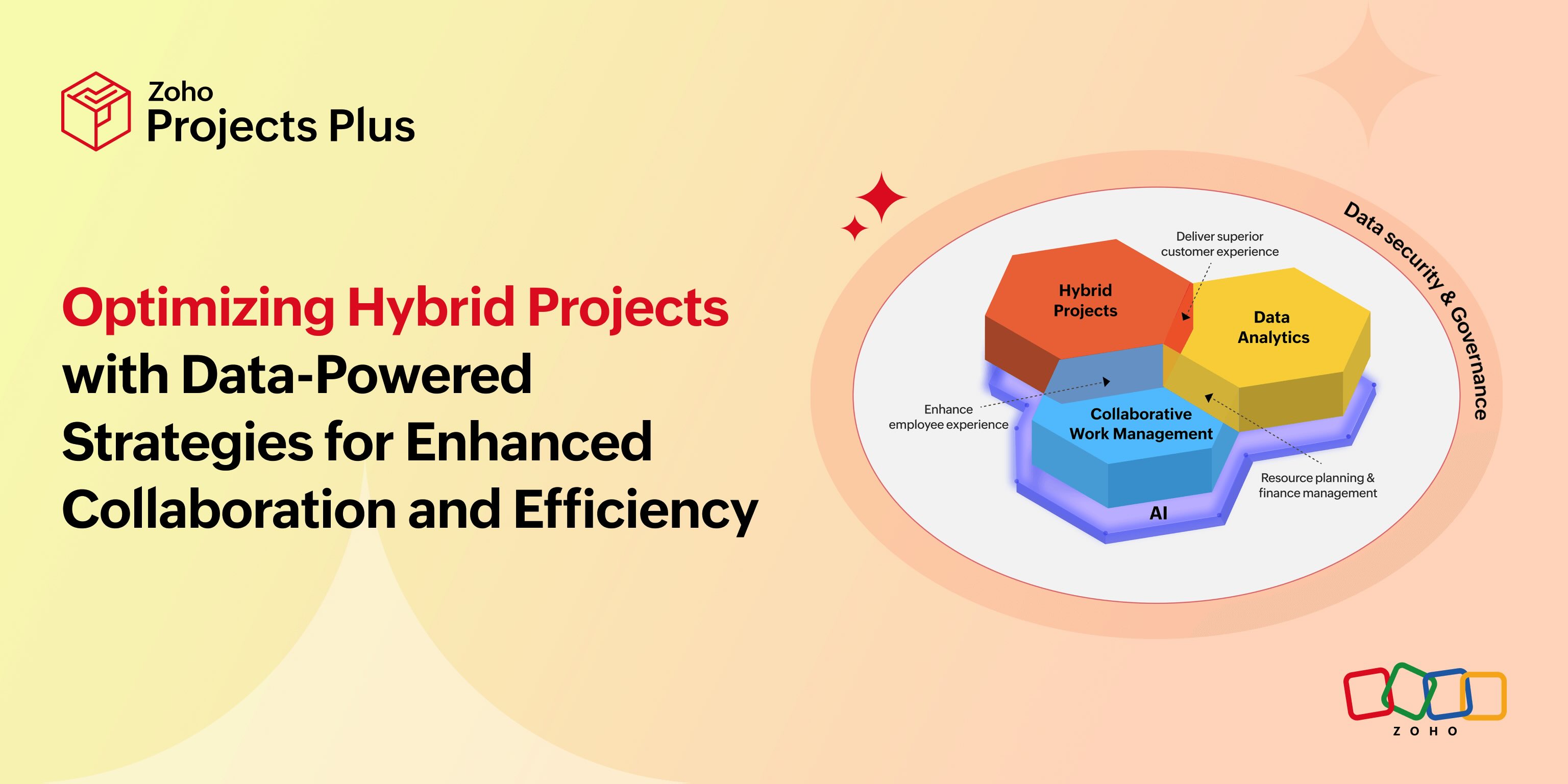- HOME
- Project Management
- The evolution of business software: A detailed look at present problems and future outlook
The evolution of business software: A detailed look at present problems and future outlook
- Last Updated : April 10, 2024
- 1.2K Views
- 9 Min Read

If you're reading this blog post, regardless of your job title, you’re probably using a ton of SaaS tools to optimize your business operations. In fact, it isn’t an understatement to say that the SaaS model has become somewhat of a cornerstone for many businesses worldwide.
According to Gartner, despite significant layoffs in the tech industry over the last year, IT spends are showing no signs of slowing down. They’re predicting that businesses across the world could spend approximately 6.8% more than last year—possibly even reaching the $5 trillion mark!
This isn’t without a good reason.
The phenomenon of digital transformation has been an absolute blessing for businesses. With SaaS, businesses spent a lot less to gain access to enterprise-level tools that helped them take their operations to the next level. All they had to do was pay a monthly fee for robust, powerful tools that they didn’t need to update, fix, or maintain themselves.
If the story stopped there, it would’ve been a dream come true for many businesses.
However, there's more to this story.
Experts across different fields are in a paradoxical dilemma. The increasing number of SaaS choices, offering solutions across verticals and operations, has not only induced decision paralysis and operation inefficiencies but is also causing a huge dent in organizational pockets.
In this post, we'll explore the issues plaguing the current operational productivity landscape. We hope to provide clarity amidst the chaos, and offer actionable solutions that you can take to navigate the SaaS jungle by acting as a compass to guide you through your productivity journey.
The SaaS conundrum
In the middle of the SaaS model lies a huge conundrum that most businesses grapple with—the dual promise of lower costs and greater efficiency versus the reality of escalating expenses and operational complexities.
On the surface, the affordable, no-commitment monthly licensing fee should theoretically eliminate the financial burden of hiring an in-house software development team. However, as organizations begin to adopt more SaaS products to meet their different needs, a significant financial burden creeps in.

Just a few years ago, if your organization had more than 2,000 employees, chances were that your organization used 175 different tools, on average.
This phenomenon, called the SaaS sprawl, is rampant, forcing businesses to really take a deep, hard look at their software acquisitions. Especially in the current economic situation, the impact of 175+ monthly subscriptions is clearly felt.
The realization that a significant portion of these expenses are going towards unused features compounds the financial burden. A startling 97% of decision makers are unaware of the full scope of SaaS applications deployed and used by their employees.
Mark Piffl, an enterprise cloud security and risk management advisor, recently wrote an article on LinkedIn about this exact problem, saying in part: "SaaS has made our lives easier with applications doing much of our necessary work and keeping track of daily business functions...but who is keeping track of SaaS applications within their organization? The answer is usually (and unfortunately) nobody!"
If these financial and decision-making challenges weren’t bad enough, the problem gets even more pervasive. It seeps all the way into the workplace floor, creating operational inefficiencies and impacting businesses in an even bigger way.
Siloed data and fragmented workflows: The need for seamless integrations
Fragmented workflows and siloed data is one problem with using many different SaaS applications. In theory, the digital age should be able to serve you seamless integrations on a platter, but that's hardly the case.
There are a considerable number of applications on the market with significant adoption rates that solve one problem, and do it well. However, this often leads to licensing many different applications to solve many different problems that employees face on a regular basis.
Even if we consider that purchasing these different applications creates a net gain for the organization, the problem is these applications don't talk to each other well, creating a complete lack of transparency to make any decisions whatsoever.
Andrew Larssen, an enterprise IT specialist at PA Consulting, noted on this awhile ago, saying, "If you have a sales system or manufacturing system, you need to transfer data between them. Without being able to do that, you end up with business silos or rekeying data. Data is the lifeblood of a business, and it needs to flow around."
However, that’s not to say that SaaS applications lack integration options altogether. Many applications are happy to provide API-level integrations to other products, offering an easy way to solve these issues. But these problems aren't completely solved yet because teams are starting to rely on a third-degree solution—integration platform as a service (iPaas) tools.
The irony of the third-degree solution: Not good enough
To address the challenges posed by SaaS sprawl and integration complexities, organizations often turn to what may seem like a logical solution: deploying additional SaaS tools designed to manage and integrate existing applications. Unfortunately, this approach, known as the "third-degree solution," introduces its own set of paradoxes and complexities.
At its core, the third-degree solution involves implementing SaaS tools that act as middleware, connectors, or integration platforms, with the goal of streamlining data exchange and workflow orchestration between disparate SaaS applications. While this approach holds promise in theory, the reality often falls short.
One of the key ironies of the third-degree solution lies in its reliance on SaaS tools to manage other SaaS tools—a scenario that can perpetuate the very challenges it seeks to address. Organizations may find themselves entangled in a web of dependencies, where the introduction of yet another layer of SaaS applications only serves to compound integration complexities and increase dependency on external vendors.
Moreover, the effectiveness of third-degree solutions is contingent upon their ability to integrate with existing SaaS applications—a feat that is often easier said than done. Compatibility issues, data-mapping challenges, and evolving APIs can hinder the effectiveness of these tools, leaving organizations grappling with incomplete or suboptimal integrations.
Don’t overlook the financial implications of deploying third-degree solutions. While these tools may offer potential cost-savings by streamlining integration efforts, the initial investment, ongoing maintenance costs, and subscription fees can escalate quickly, adding to the already substantial expenses associated with SaaS adoption.
In light of these complexities, organizations must approach the third-degree solution with caution and foresight. Strategic evaluation of integration needs, careful selection of third-degree solutions based on compatibility and scalability considerations, and ongoing monitoring of integration effectiveness are essential to mitigate the risks and maximize the benefits of this approach.
For argument's sake, let’s say that even if these problems are solved by using iPaaS, or we lived in an ideal world where integrations between different apps are executed to perfection, there's another problem that organizations must grapple with—the human element.
The human element
As organizations grapple with the complexities of SaaS adoption, it's crucial not to overlook the human element—the individuals tasked with implementing, using, and managing these digital tools. From training and adoption hurdles to user resistance and tech literacy challenges, the human factor plays a pivotal role in the success or failure of SaaS initiatives.

One of the primary challenges organizations face is the cost and time associated with training employees on multiple SaaS platforms. With the rapid pace of technological change and the constant influx of new tools, employees may struggle to keep pace with evolving software interfaces and functionalities.
Middle management, in particular, may find themselves burdened with the responsibility of upskilling teams while balancing day-to-day operational demands.
User resistance presents a significant barrier to SaaS adoption, particularly among tech novices. The reluctance to embrace new tools and workflows can stem from a variety of factors, including fear of change, skepticism about the benefits of SaaS, and concerns about job security.
As a result, organizations may encounter resistance from frontline workers who struggle to understand and use complex SaaS products effectively.
Stories from the ground highlight the real-world challenges faced by workers grappling with the complexities of SaaS adoption. From frustration over cumbersome interfaces to confusion about workflow processes, employees may feel overwhelmed and disempowered by the very tools meant to enhance their productivity.
Apart from all of this, we haven't really gone into detail about the security concerns and compliance headaches associated with onboarding SaaS products. If you want to read more on these issues, check out this article by Sethu Meenakshisundaram of Zluri.
The direction for the future
While the world is still grasping for solutions, we believe that opting for a single vendor would solve most, if not all of the issues that SaaS sprawl presents.

Before we explain how shifting to a single vendor works, let's take a brief look at all of the problems that businesses face when going with multiple SaaS tools from different vendors:
- High monthly costs.
- Lack of visibility to internal decision makers.
- Lack of integrations, leading to error-filled data or even data silos.
- The necessity for additional products to manage and handle existing products.
- The additional cost of training employees to use and operate the different applications efficiently.
- Legal, security, and other onboarding issues when adopting new products.
By switching to a single software provider, you're not only likely to reduce costs, but the efficiency at which your organization operates is sure to increase the returns you’ll see as well.
Take the case of Rain for Rent, for instance. They’re a provider of temporary liquid handling solutions, and they were using multiple legacy applications to take care of their operations. After switching to a single vendor and retiring legacy applications, the company saw as much as a 610% increase in their ROI.
More often than not, these bundles will come with an admin panel to enable instant visibility to all of the necessary decision makers the organization deems necessary.
Data integration is no longer a problem—the apps are highly likely to communicate transparently with each other, destroying redundancies and siloed data, enabling faster, effortless decision-making.
For example, Robert Hudman, CEO of Knight Solutions, says, "I could try and look for better solutions, but if I did that, I would end up with all these point solutions that don't actually connect. We would lose so much.”
Because bundles would also have a single source of truth, you wouldn't have to rely on a third-degree solution to ensure seamless integrations or even worry about data silos.
Legal compliances, data security audits, and other onboarding processes will be cohesive if you shift to a single vendor offering applications for all of the use cases you'll need. Instead of having to conduct audits and review contracts for every single application or product you use, you now have the luxury of doing it once for the whole bundle, which drops your costs significantly.
The same goes for training employees to use the products. Individual products are likely to maintain similar design philosophies, helping employees transition between the different apps without having to think twice.
There is a catch, though. Not all vendors and products are created equal. You’ll have to go through a series of checks and balances before choosing a vendor.
- The software stack should be robust and able to take care of all your business needs. Don’t settle for a vendor at the cost of missing out on some of the features your organization relies on.
- Make sure that privacy, security, and legal compliances are on point, especially if you're exploring a vendor who caters to international users.
- The software suite must be easy to use, intuitive, and, more importantly, easy to train new employees on.
- The suite has to provide actual value for the money and have transparent pricing structures.
Now that you've come to the end of this article, we sincerely hope that you don’t relate to any of the problems that we've talked about. We hope that the solutions you've opted for work like clockwork and that you don’t have to change anything.
If you do relate to any of these problems, you’ve seen them firsthand in your organization, or have even a single doubt that they might be plaguing your company's efficiency, perhaps it's time to reevaluate your SaaS strategy. We’re not just talking about saving costs here; we’re talking about doing way more with way less.
We can truly embrace data-driven decision making across verticals, and achieve the true vision of SaaS—helping businesses make full use of the latest technology at a fraction of the cost.
 Anirudh Kidambi
Anirudh KidambiProject management enthusiast by day, F1 and Esports connoisseur by night, and all time pizza virtuoso.




